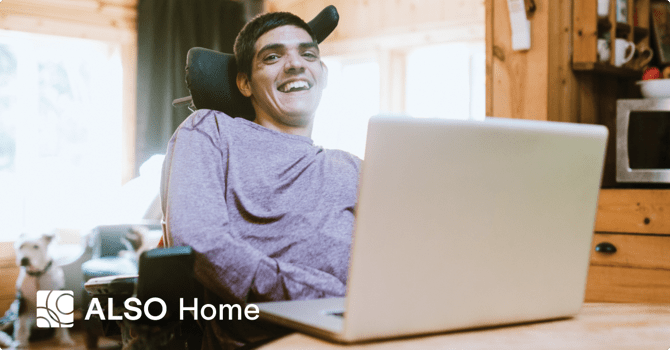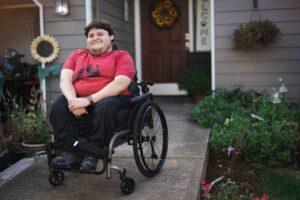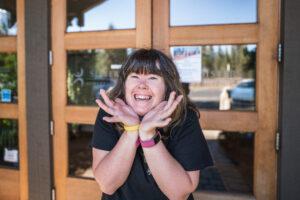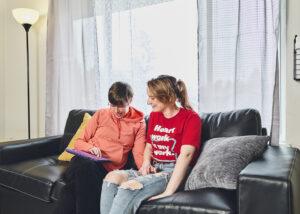Affordable housing for people with I/DD is in low supply. Learn what ALSO is doing to make a difference.
Affordable housing for people with I/DD is in low supply. Learn what ALSO is doing to make a difference.


In a very broad sense, most of us have used some kind of assistive technology (AT) during our lives. Consider eye glasses, contact lenses, or hearing aids. Wheelchairs and grab bars, a must for many individuals with physical disabilities, are also considered assistive technology. These items are critical to meeting career, academic, recreational, and self-care needs.
When it comes to education, assistive technology is a definite game-changer for students with developmental or intellectual disabilities. The Individuals with Disabilities Education Act defines assistive technology devices as items, equipment, or systems that serve to “…increase, maintain, or improve the functional capabilities of a child with a disability.”
Often, we think of assistive technology devices as complex and expensive electronic systems or computer software. Although this is true in some cases, there are multiple types of assistive devices that are simple to use, inexpensive, and easy to obtain. At ALSO, our direct support professionals (DSPs) are dedicated to helping students with intellectual and developmental disabilities to use devices that best suit their learning and academic needs.

For kids with intellectual and developmental disabilities, assistive technology can take a variety of different forms. A lot of these tools are considered low tech, and often already available in teachers’ classrooms. Here are a few examples:
Even some of the more complex AT is likely to be available in most classrooms:
We are living during an innovative and exciting time in the development and acceptance of assistive technology for people of all ages and types of disabilities. There are many high tech assistive devices in existence today that have had a major positive impact on younger students, teenagers, and those attending higher education institutions.
CHECK IT OUT: How ALSO effectively uses assistive technology to help the people we support lead more fulfilling and independent lives.
CHECK IT OUT: A very determined student with cerebral palsy proceeds from grade school into college.
Augmentative and alternative communication devices (AAC) can be low-tech as well as high-tech. According to the American Speech-Language and Hearing Association, children who may have communication challenges can learn to share their ideas and feelings in ways that require no technology whatsoever through:
Some high-tech options can include apps or iPads. For students with certain speech impairments, computers also have “voices,” also known as speech-generating devices. Essentially, AT is going to be anything that assists the user in a variety of tasks. For students, it’s something that helps them to learn, study, explore, and communicate. Let’s not forget the need for all students with disabilities to play and participate in extracurricular activities of their choice. To put it simply, assistive technology helps students enjoy being kids!

Assistive technology support services help students with disabilities achieve their fullest potential in academic performance. We don’t often realize that the school years (even in early childhood) are pivotal to the development of social skills, self-confidence, independence, and self-empowerment. The appropriate assistive technology can meet the specific needs of students with virtually any type of disability.
Undoubtedly, the possibilities of what can be done with the appropriate assistive technology are truly endless!

Education advocates emphasize that the United States education system is all about the democratization of knowledge. In 2011, 22% of adults with disabilities had less than a high school education. The adoption of appropriate assistive technology for students leads to increases in academic performance, independence, and opportunities for competitive employment.
A systematic review of studies conducted between 2009 and 2020 revealed that a steady increase in the use of AT in education began in about 2017. Although research on assistive technology has received world-wide attention, it’s been pursued mainly in the US, followed by Brazil and Turkey. This systematic review documented several positive impacts on students with various types of disabilities:
Thankfully, the above benefits expand beyond students in K-12 classrooms. Even college students with disabilities have reported many psychosocial benefits of access to AT:
At ALSO, we firmly believe that these academic and psychosocial benefits create a higher level of adaptive change: a person’s approach to life. Something that once felt impossible…with thoughts of, “I can’t do that”…or, “I’m not good at it…” is now an everyday reality. For example, a student who uses assistive technology devices is not only getting better grades in school, but they are able to tell jokes and express their unique sense of humor. One of our staff members clearly remembers the exciting day when one of the individuals we support learned how to use their communication device to curse! “It’s simply a part of being involved in the real world! This is so wonderful because, thanks to AT, students with disabilities have the opportunity to reshape their internalized beliefs about themselves before their egos are fully formed.”
This, in fact, is the root of our Heart Work at ALSO. We are completely dedicated to our Vision of community inclusion for people with intellectual and developmental disabilities:
ALSO envisions a future in which all people, including those living with developmental and other disabilities are fully included, participating members of their communities. We see equitable access to supports and services that reflect the preferences and values of diverse communities and that lead to self-determination, independence, productivity, and a healthy and satisfying quality of life.

The facilitation of the appropriate assistive technology devices takes a true team effort. Not only do our DSPs advocate and provide training in assistive technology, but professionals in our local school districts play a pivotal role in giving people with disabilities every possible opportunity to move forward in life.
The advances in various digital tools over recent decades have occurred in school districts throughout the United States school systems, including in higher education institutions. It’s now quite common to see entire classrooms of students who freely use laptops and iPads.
An important distinction needs to be made, however, that when a student who has a disability is otherwise prevented from making academic progress without the iPad or laptop, then that device becomes a form of assistive technology that’s necessary for academic performance. This is why ALSO readily partners with children’s support systems to form what’s known as an IEP Team, which stands for Individual Education Plan. The IEP Team includes virtually anyone who could have a positive impact on the student’s life, for example:
CHECK IT OUT: Our decades-long reputation as true team players is reflected in the History of ALSO.
So, when it comes to advocating for the appropriate assistive technology devices for students with intellectual and developmental disabilities, the dedicated professionals at ALSO are proud leaders for Oregonians experiencing disabilities. We know that all students growing up in our classrooms today represent a bright future and success in the challenges of tomorrow for all of us.
Want to learn more about the many services provided by ALSO?
Schedule a Get to Know Us Tour!

Sign up for our newsletter to get our latest news, content, and job opportunities.
Help us ensure that everyone has the same opportunities in their home, workplace and community. Let’s make dreams!

Notifications